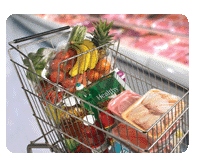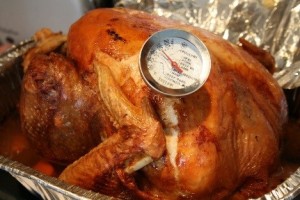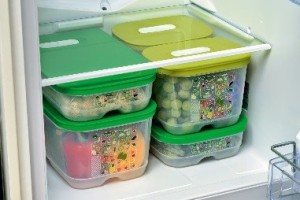Clean
Illness-causing bacteria can survive in many places around your kitchen, including your hands, utensils, and cutting  boards. Unless you wash your hands, utensils, and surfaces the right way, you could spread bacteria to your food, and your family.
boards. Unless you wash your hands, utensils, and surfaces the right way, you could spread bacteria to your food, and your family.
• Wash hands before, during and after preparing food. Then again before eating.
• Wash surfaces and utensils after each use.
Separate–Don’t cross-contaminate!
Even after you’ve cleaned your hands and surfaces thoroughly, raw meat, poultry, seafood, and eggs can still spread illness-causing bacteria to ready-to-eat foods—unless you keep them separate.
illness-causing bacteria to ready-to-eat foods—unless you keep them separate.
- Use separate cutting boards for produce and for meat, poultry, seafood, and eggs.
- Keep meat, poultry, seafood, and eggs separate from all other foods at the grocery.
- Keep meat, poultry, seafood, and eggs separate from all other foods in the fridge.
Cook
 Did you know that the bacteria that cause food poisoning multiply quickest in the “Danger Zone” between 40˚ and 140˚ Fahrenheit? And while many people think they can tell when food is “done” simply by checking its color and texture, there’s no way to be sure it’s safe without following a few important but simple steps.
Did you know that the bacteria that cause food poisoning multiply quickest in the “Danger Zone” between 40˚ and 140˚ Fahrenheit? And while many people think they can tell when food is “done” simply by checking its color and texture, there’s no way to be sure it’s safe without following a few important but simple steps.
- Use a food thermometer.
- Keep food hot after cooking (at 140 ˚F or above).
- Microwave food thoroughly (to 165 ˚F).
Chill
Did you know that illness-causing bacteria can grow in perishable foods within two hours unless you refrigerate them? (And if the temperature is 90 ˚F or higher during the summer, cut that time down to one hour!)
- Refrigerate perishable foods within two hours.
- Your freezer should be 0 ˚F or below.
- Never thaw or marinate foods on the counter.
Source: Food Safety.gov This institution is an equal opportunity provider and employer.

